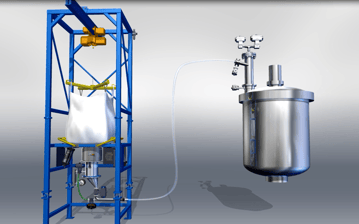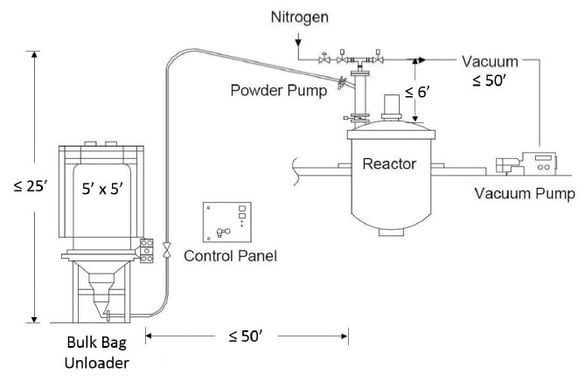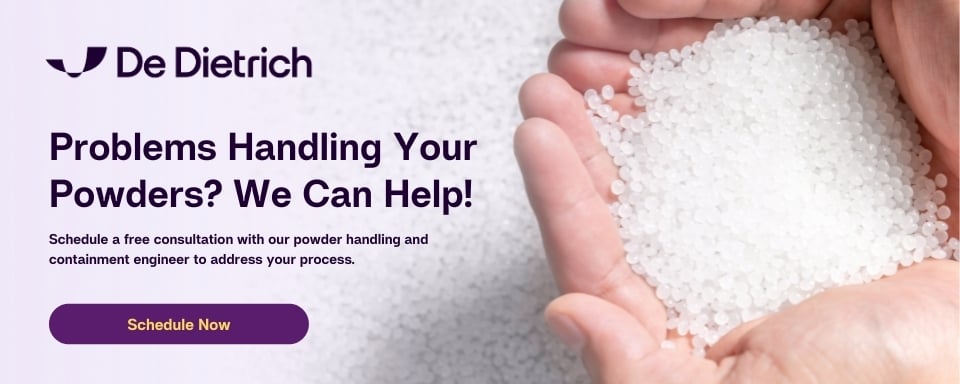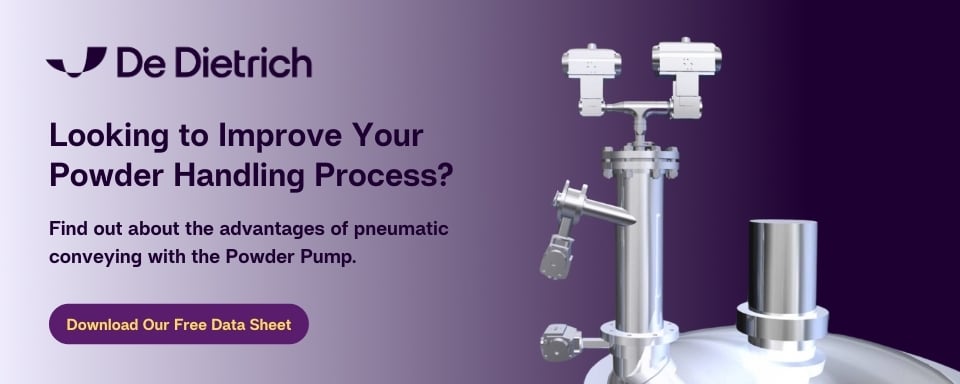Identifying Basic Powder Handling Solutions: Bulk Bag Transfer System
 The design of solids transfer systems can vary greatly from one application to another, depending upon the product’s characteristics and the requirements of the process. However, there are a few basic system designs that quite often successfully address an application with only minor modifications for specific issues.
The design of solids transfer systems can vary greatly from one application to another, depending upon the product’s characteristics and the requirements of the process. However, there are a few basic system designs that quite often successfully address an application with only minor modifications for specific issues.
To help clients understand these basic system designs, we are creating a Powder Handling Solutions Portfolio that describes the major components, installation arrangements and standard capabilities of these systems.
The first application we have addressed covers, “Transfer of Solids from Bulk Bags (FIBCs) to Mixing Vessels”. It can be downloaded as a pdf, and/or read about in detail below.
System Features
The basic, major components of a DDPS Bulk Bag transfer system include:
1. Bulk bag (FIBC) unloader – This device consists of a support frame onto which an FIBC is lifted and placed via a pneumatic or electric hoist and trolley. A bag spout sealing valve, clamping ring, and containment housing work together to provide a dust-free environment. Flow promotion devices help to facilitate bag emptying, and the fluidizing hopper ensures conveying gas and solids are mixed in the appropriate ratio.
2. Powder Pump unit – The Powder Pump system is literally and figuratively “the heart” of the system. It conveys material from the Bulk Bag unloader outlet under “dense-phase” conditions, and delivers it into the receiving vessel, while maintaining the vessel’s inert environment. The system design also dissipates static build-up to prevent a spark discharge, which is a frequent problem when pneumatically conveying solids.
3. PLC-based controls – Clear and intuitive HMI displays are rated for Class 1, Division 2, Group C & D. Additional customized programming is also available and can be designed to meet specific needs.
The schematic below represents the standard arrangement for this system, with typical dimensions provided.

How Does It Work?
Bulk bags, or FIBCs, are commonly used to supply relatively large amounts of solids to manufacturing facilities (vs. sacks and drums that are typically used for smaller quantities). These solids are often transferred into a mixing vessel for dissolution in a solvent. When the solids, and/or the solvent are flammable, explosive or toxic, special care must be taken when conducting the transfer operation. The solids are removed from the FIBC in a contained manner, and pneumatically conveyed at a controlled rate to the receiving vessel. Either atmospheric air or nitrogen can be used as the conveying gas. In both cases, the Powder Pump unit allows the solids to be delivered into the vessel without loss of its inert, internal atmosphere.
The pneumatic transfer system described above was developed to provide a total solution while providing operator safety and environmental protection. Complete process control ensures superior product quality, and the dust-free, closed system simplifies general housekeeping and maintenance duties.
Common Applications
This solution can efficiently and reliably transfer material for various applications across a wide range of industries. Some examples include, but are not limited to:
- Specialty Chemical and API Reactions
- Pigment and Paint Blending
- Petrochemicals Manufacturing
- Food and Flavors Mixing
- Electrical Component Manufacturing
Benefits to Users
The bulk bag transfer system eliminates the need to manually charge multiple small sacks or drums of material. This not only saves time and labor, but improves operator safety since vessel manways are no longer required to be opened.
System Enhancements
As previously stated, this basic system design adequately addresses many material transfer applications. However, system enhancements are available to provide more customization and functionality when necessary. Some popular upgrades include:
- Hydraulic conditioners to break-up solidified materials inside FIBC
- Solids delumper for additional size reduction
- Load cells for batch weight monitoring and transfer rate control
- Custom hoppers to address bridging or rat-holing
- Electrical grounding and oxygen content monitoring systems
By identifying and outlining our core powder transfer system arrangements, we hope to make it easier for you to understand the fundamental solutions we can offer and how they would fit into your operation. If you have any questions, or would like to speak with one of our Powder Handling Engineers to discuss your application in more detail, contact us online or fill out our Powder Handling Application Questionnaire.
Watch for more solutions to be added to our portfolio in the upcoming weeks or subscribe to our blog to receive notifications.


